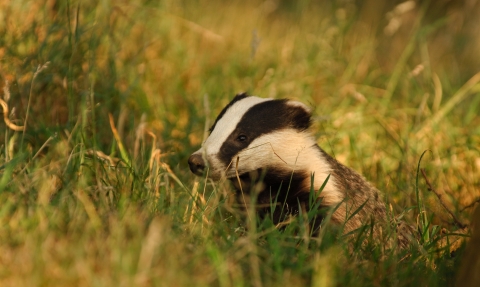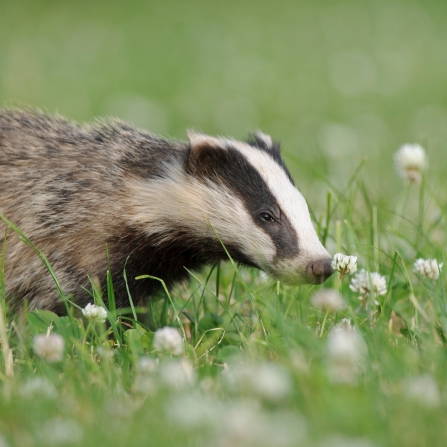
Badger © Andrew Parkinson/2020VISION
Badger Cull
The Wildlife Trusts have opposed the badger cull since it first started and no Wildlife Trust will allow badger culling on its land.
"Evidence shows that badgers are not the primary cause of the spread of TB in cattle and that the primary route of infection is from cow-to-cow contact – so a vaccine for cattle should be a government priority. While we wait for this to happen, Wildlife Trusts have been and will continue to, vaccinate badgers. Since 2011, Wildlife Trusts have vaccinated around 1,000 badgers on our nature reserves and in the wider countryside in partnership with vets, farmers and landowners. Many farmers recognise that badger vaccination is a positive alternative to culling, and working alongside them is the right way forward."
Ellie Brodie, Senior Policy Manager, The Wildlife Trusts

Badger (meles meles) - © Andrew Mason
What is bovine tuberculosis?
Bovine tuberculosis (bTB) is a highly infectious disease of cattle which devastates thousands of farming businesses annually. Since the mid-1980s, the incidence of bTB in cattle has increased substantially creating an economic burden on the taxpayer and the farming industry, as infected cattle must be culled.
Government research shows that bTB is not a major cause of death in badgers. Generally, infected badgers do not show any sign of infection and can survive for many years before suffering from severe emaciation.
83% of badgers culled in government trials 2002-2005 tested TB free.
Why are badgers being culled?
Badgers are being culled as part of a government initiative to reduce the spread of bovine tuberculosis (bTB) in cattle. Pilot badger culls commenced in 2013 in Gloucester and Somerset amid much opposition. More than 300,000 people supported a petition opposing the cull. An Independent Expert Panel (IEP) was appointed by Defra to assess the effectiveness, humaneness and safety of the 2013 culls. The panel deemed the culls 'ineffective' and 'inhumane' in 2013, with no significant improvement - and further failures - in 2014. Despite two parliamentary debates, a prominent opposition campaign and the support of numerous experts and high profile figures, the number of areas increased in 2015 to include Dorset. In August 2016, the Government announced seven new cull licenses across three new areas (Cornwall, Devon and Herefordshire) for an extension of the cull.
In September 2017, the Government licenced 11 new areas and authorised two new supplementary licenses in Gloucestershire and Somerset. This brings the total number of badger cull areas to 21. The badger cull now operates across Cornwall, Devon, Dorset, Wiltshire, Gloucestershire, Herefordshire, Cheshire and Somerset. In total, 19,274 badgers were culled in the 2017 badger cull in England.
In 2018, at least 32,601* badgers were culled across 32 badger cull zones in England. The badger cull has gone ahead for the first year in Staffordshire and Cumbria, in addition to the existing areas of Gloucestershire, Somerset, Dorset, Cornwall, Devon, Herefordshire, Cheshire and Wiltshire.
*Data on the number of badgers culled in Areas 1 and 2 (in Gloucestershire and Somerset), and the Low-Risk Area (in Cumbria) are yet to be released.
What do The Wildlife Trusts believe?
We are very conscious of the hardship that bovine TB (bTB) causes in the farming community and the need to find the right mechanisms to control the disease. However, we believe that a badger cull is not the answer. The scientific evidence demonstrates that culling is likely to be ineffective in fighting the disease and, worse still, risks making the problem even worse. We believe the emphasis of all our efforts should be to find a long-term solution and we are calling for the Government to end its policy of culling badgers.
This is a cattle problem, not a badger problem
The control of Bovine TB in cattle should be the main focus of everyone’s efforts to control this problem. The evidence shows that badgers are not the primary cause of the spread of TB in cattle: the primary route of infection is via cow-to-cow contact.
A vaccine for cattle should be a priority
The Government has failed to develop one for TB. UK Cattle are already vaccinated for up to 16 diseases so why should TB be different?
The cull is scientifically unsound
The results of the previous badger culls indicate that this policy is flawed and unsupported by the evidence. In 2014, scientist and badger expert Rosie Woodroffe deemed the cull ‘scientifically rubbish’ in response to changing Government targets. Culling has been shown to be more expensive, less effective than other bovine TB (bTB) control mechanisms and the free-shooting of badgers has been shown to be an inhumane method of killing.
What are The Wildlife Trusts doing?
The Wildlife Trusts have been working on the issue of bTB and its links to badgers for several years. During this time, our activities have included:
- undertaking badger vaccination programmes since 2011 on our nature reserves and in the wider countryside in partnership with vets, farmers and landowners (14 Wildlife Trusts have been involved in these vaccination programmes)
- standing up for badgers in local and national media
- petitioning the Prime Minister to drop the Government’s failed badger cull policy and develop an alternative strategy to tackle bTB
- lobbying the government to develop a cattle vaccine and implement an all-encompassing badger vaccine strategy
- collating, summarising and presenting the science on the spread of bTB
- encouraging our members and supporters to write to their MPs to press for a different approach to eradicating bTB, without culling badgers.
- working with Defra on a Badger Edge Vaccination Scheme
- supporting and promoting e-petitions to stop the cull
